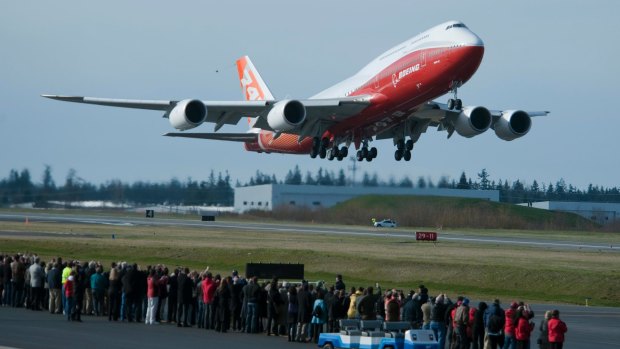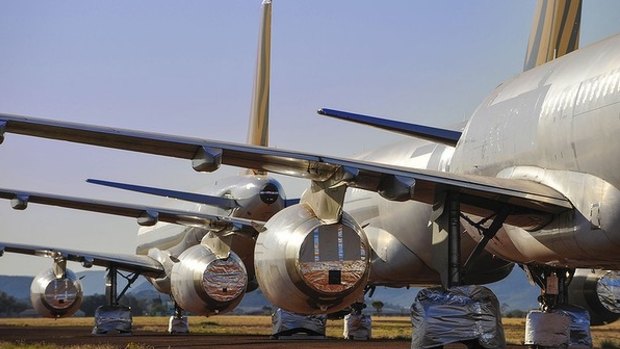This was published 5 years ago
Boeing 747 jumbo jet turns 50, but its future remains uncertain
By Hugh Morris
In the skies above Washington state, 50 years ago, the Boeing 747 performed its first turns. The debut flight - despite a minor problem with one of the wing's flaps - was counted as a success, and the course of air travel history was changed for good.
The original Jumbo Jet, the Queen of the Skies, the bubble-topped Boeing: in the Seventies the 747's vast size made long-haul travel a viable option for the masses for the first time. Since that February morning in the north-west of America (that aircraft, the RA001, can today be seen at Seattle's Museum of Flight), more than 1500 of the aircraft have been built, serving the world's airlines tirelessly.
"It's not a stretch to consider the advent of the 747 as the most crucial turning point in the history of civil aviation," writes author and pilot Patrick Smith in his book Cockpit Confidential.

The latest, and possibly last, version of the 747, the 747-8, takes off on its first flight from the Boeing factory in 2010. Credit: Jim Anderson
But here, half a century later, the 747 is disappearing from the skies as the likes of Qantas, British Airways, Virgin Atlantic and Lufthansa phase them out in favour of newer planes; yet still the production plant rumbles on, with newer variations and an increased desire for the jet as a cargo aircraft.
There is, however, no denying that the sun is setting one of the most iconic aircraft ever developed. Its humped front and staggering tail have become the casual blueprint for many an imagining of air travel, despite no other plane looking like it. It carries with it a romance like no other.
"The plane looks less like an airliner than it does an ocean liner in the classic QE2 mold," says Smith. "[It] is arguably the most impressive and inspirational work of art - call it industrial art, if you must - ever produced by commercial aviation."
Beyond its pin-up potential, the 747 has meant a lot to many passengers over the years.
"There's always love and happiness and excitement in the cabin," says senior first officer Bernice Moran, who flew the 747, which she describes as "beautiful, gracious", for Virgin Atlantic. "Because we fly it on our leisure routes, it's always so special to see families and newlyweds on the plane. Any passenger that I've spoken to over the last 12 years has felt blessed to fly on such an iconic aircraft."
Bernice said she first saw a 747 as a child as it came into land at Dublin Airport, near where she grew up. "Sometimes I'm in disbelief that I've been given this 300 tonne jet to fly," she says. "It's one of the airplanes that most pilots would dream to fly and I have been lucky enough to fly it."
How long does the 747 have left?
While there remain many in the skies today, hundreds more have been scrapped. Qantas will phase out its remaining 747s by 2021, while British Airways has said it will have bid farewell to its last 747 by 2024, both welcoming a new age of airliners, such as the 787 Dreamliner and A350. Virgin Atlantic, too, is set to replace its 747s with the Airbus A350-1000.
Singapore Airlines was one of the first carriers to stop flying 747s, with its last jumbo jet making its final flight in 2012.
Demand for the 747, which has been tweaked and upgraded many times since its first flight in 1969, has dried up. Only 18 orders were received last year and it is expected that Boeing will be forced to call time on the jumbo jet before long.
That said, it was only in 2017 that the US government asked Boeing to repurpose two 747-8 aircraft for use as Air Force One. The aircraft are due to be delivered by the end of 2024.
Where do unwanted 747s go?

Credit: Steve Strike
With airlines keen to keep their fleets as modern and fuel efficient as possible, and air forces eager to take advantage of new technology, the shelf life of a plane is shorter than you'd think. Where do they go when they are retired? The chances are they will end up at one of the world's vast aircraft graveyards.
There are dozens of facilities around the world where retired planes are kept in storage or to have their parts removed and reused or sold. The first such graveyards, or "boneyards" in US parlance, were established after the Second World War, when militaries found themselves with huge aircraft surpluses.
The largest is the 309th Aerospace Maintenance and Regeneration Group at the Davis-Monthan Air Force Base in Tuscon, Arizona, where almost 5000 have been left to gather dust.
Aircraft graveyards can also be found beyond US shores, in Alice Springs Airport, Northern Territory, Australia; Manas International Airport in Bishkek, Kyrgyzstan; Teruel Airport in Aragon, Spain; and Tarbes–Lourdes–Pyrénées Airport in France.
The Telegraph, London
Sign up for the Traveller newsletter
The latest travel news, tips and inspiration delivered to your inbox. Sign up now.